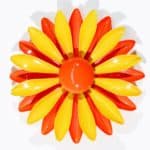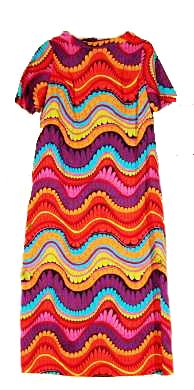The exhibition Fashion as Experiment: The ’60s explores clothing as a tool for change, with a focus on mid-1960s styles that offered young people a laboratory for imagination, play, and a growing sense of activism. On view from May 6 through September 24, 2023, the exhibition includes more than a hundred garments and accessories from the Museum’s collection, some by iconic designers such as Geoffrey Beene, Emilio Pucci, Bonnie Cashin, and André Courrèges. Museum members get a first look during an exclusive Preview on Friday, May 5, from 6 to 8 p.m.,

Pin, 1960s, polychrome steel. Collection of Ellie Laubner, 2009 (2009.12.667)
Fashion as Experiment is structured in two parts. The first section, spread across two galleries, presents styles such as Mod, Pop, and psychedelia that laid the groundwork for clothing to take on connotations of rebellion in the late 1960s. Bright colors and unconventional materials express a spirit of futurism and experimentation. Youth fashions such as paper dresses emphasized novelty and low price, defying ideals like quality and elegance that shaped the wardrobes of older generations. Floral and psychedelic prints captured the decade’s exuberant and irreverent attitude that allowed young women to envision an adulthood unburdened by the traditional feminine responsibilities of home and family. Similar styles in men’s and women’s clothing blurred gender boundaries, and miniskirts, hot pants, and dresses with cut-outs evoked the 1960s sexual revolution.

Alex Colman, Dress, late 1960s-early 1970s, polyester. Collection of Ellie Laubner, 2009 (2009.12.517)
The second section, located in its own gallery, closes the exhibition with countercultural looks from the late 1960s and early 1970s, including globally inspired fashion as well as thrifted and handmade garments. Young people adopted these styles in protest of the materialism, racism, and imperialism they saw in American society; to show support for causes like the antiwar and Civil Rights movements; and to reject the Western fashion establishment. This section also includes mass-produced garments based on these hippie looks, showing the commercialization and mainstream adoption of these radical styles.
To involve our community in the exhibition, we invite locals and visitors to submit photographs of themselves or family members from the 1960s, which may be displayed in a slideshow in the gallery or share on the Museum’s social-media platforms. To learn more click HERE.
Between the exhibition and the many ’60s-fashion-related programs we will be offering Free to All throughout the summer, we hope our visitors—our longtime members and first timers alike—will be inspired to reflect on how their clothing is a space for enacting their own values.

